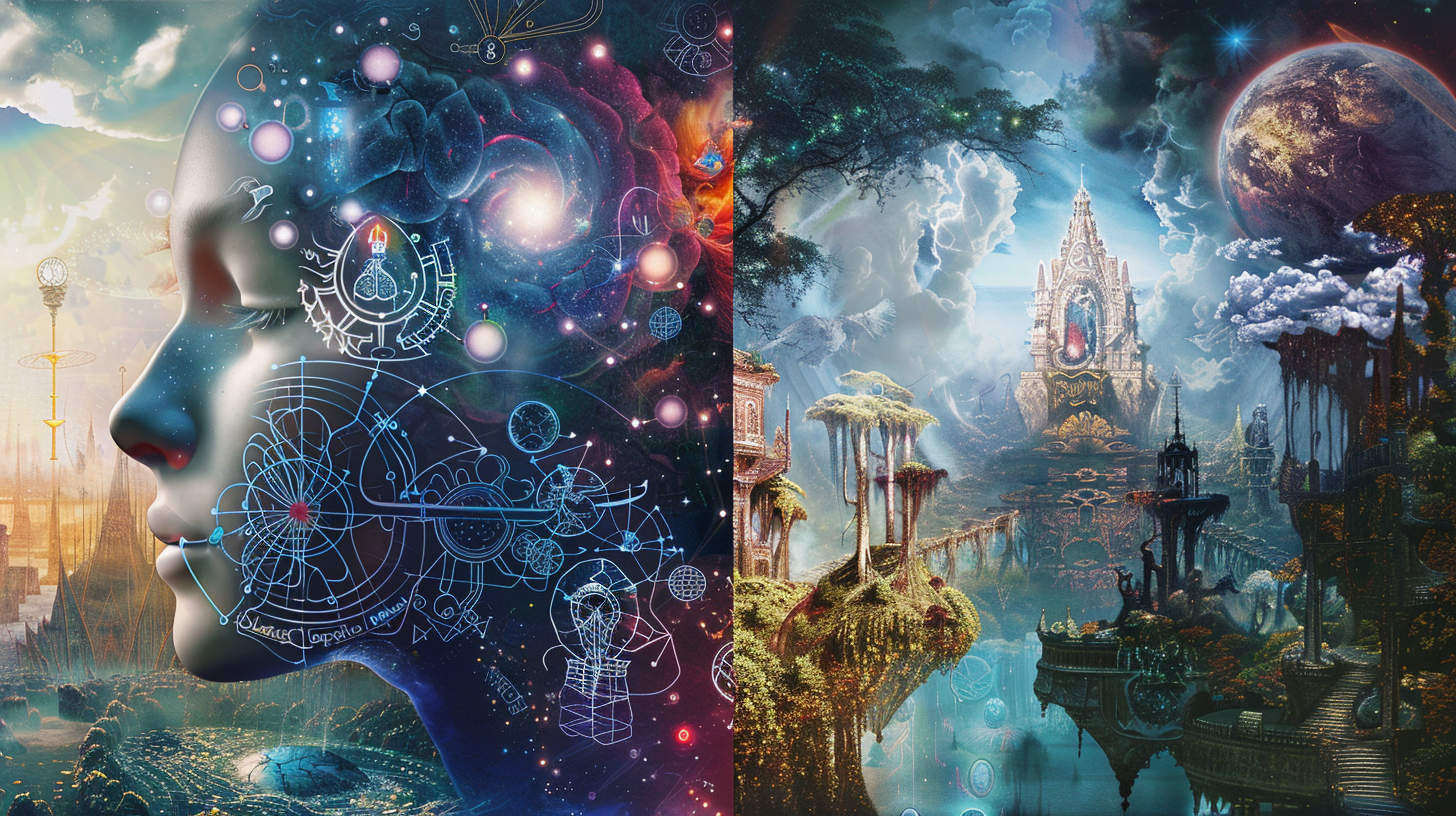Reality shifting, as intriguing as it sounds, is essentially about changing your current perspective to experience a different reality. Think of it as tuning your mind’s radio to a new frequency, where alternate realities or dimensions become accessible. This concept, blending psychological and metaphysical elements, allows for a fascinating exploration of consciousness. From the psychological angle, it’s akin to lucid dreaming or entering altered states of consciousness.
Techniques like meditation, visualization, and sensory deprivation are your tools here. They enable you to sculpt your perception, presenting a unique blend of self-awareness and imagination.
On the metaphysical side, reality shifting is thought to involve energy or vibrational frequency manipulation, opening doors to parallel universes or dimensions. Methods here might include astral projection, delving into quantum physics, or utilizing sacred geometry. The recent surge in popularity around reality shifting, especially among younger folks, can be credited to the digital age. The internet has become a treasure trove of resources, communities, and discussions, enriching the understanding and application of reality shifting. This modern renaissance intertwines with an increased societal acceptance of mindfulness, meditation, and the exploration of virtual realities, further blurring the lines between what’s considered real and what could be.
Key interests in this field now include:
- Techniques for achieving altered states of consciousness.
- The role of symbols and quantum physics in accessing different realities. – The impact of technology, like binaural beats or VR, in enhancing these experiences. – Personal stories from those who’ve ventured into other realities.
- The exploration into how these practices can benefit psychological and therapeutic outcomes.
This blend of ancient wisdom with modern science offers a compelling gateway to personal development and psychological growth, inviting you to question and expand your understanding of reality.
Tracing the Origins of Reality Shifting

The concept of reality shifting might seem like a modern phenomenon, but it’s deeply rooted in practices and beliefs dating back to ancient cultures. Imagine shamans from various indigenous tribes, entering altered states of consciousness to journey into other realms. This isn’t just fiction; it’s a well-documented facet of cultures ranging from the Siberian Yakuts to the Native American Plains tribes and the African Dogon people. These shamanic journeys are perhaps the earliest form of what we today refer to as reality shifting.
Then, there’s the tradition of vision quests, notably practiced by North American indigenous peoples like the Plains Indians and the Navajo. By fasting, meditating, and other forms of self-denial, individuals embark on a quest for visions or spiritual insight, another precursor to modern reality shifting techniques.
Diving into the Western philosophical lineage, we encounter giants like Plato and Aristotle discussing the divide between the physical world and a realm of forms or ideas. This distinction has been carried forward through history, influencing later thinkers like René Descartes, who famously asserted “Cogito, ergo sum” (I think, therefore I am), highlighting the mind’s power in defining existence and, by extension, reality.
Descartes and other philosophers, including Immanuel Kant, who explored how our perceptions shape our experience of the world, laid foundational stones for understanding reality shifting. Their work suggests that reality isn’t just out there to be observed but is also crafted by the structures and processes of our minds. In more recent times, thinkers like Alan Watts and Terence McKenna have pushed the boundaries further, exploring how language shapes reality and how psychedelic experiences could unlock hidden dimensions of existence. Their work has added layers to our understanding of reality shifting, bridging ancient wisdom with contemporary psychological theories.
Ancient Practices:
- Shamanic journeying
- Vision quests
Philosophical Contributions:
- Plato and Aristotle on the world of forms
- Descartes on the mind-body distinction
- Kant on the role of perception
Modern Explorations:
- Alan Watts on the power of language
- Terence McKenna on psychedelic experiences
The leap from these philosophical musings and ancient practices to today’s methods of reality shifting isn’t as vast as it seems. Techniques like visualization, cognitive restructuring, and meditation are modern expressions of these age-old ideas, tailored for today’s seekers of psychological growth and personal development. The journey from ancient shamanic practices to contemporary reality shifting encapsulates humanity’s enduring quest to understand and manipulate the fabric of our existence for greater life satisfaction and personal fulfillment.
Core Methods to Shift Your Reality

Exploring reality shifting techniques unveils a fascinating blend of ancient wisdom and modern innovation. Whether you’re delving into lucid dreaming, dimension jumping, or chaos magick, each method offers a unique pathway to personal development and psychological growth. Let’s dive into some of the most effective techniques that have captivated minds worldwide.
Wake Induced Lucid Dreaming (WILD)
Imagine transitioning directly from being awake into a lucid dream. That’s what Wake Induced Lucid Dreaming is all about. This technique stands out for its ability to provide control and awareness as you shift from your current reality to the desired one. It leverages breathing patterns, visualization efforts, and specific body movements, setting a unique stage for entering your dream state consciously.
Chaos Magick
Chaos Magick is your go-to if you’re fascinated by the occult but crave a dash of modern psychology. It revolves around using mental focus, visualization, and intention to bend reality to your will. By concentrating on a desired outcome and employing magickal elements like sigils and affirmations, you can potentially manifest your ideal reality. It’s a blend of the mystical and the practical, proving that your mind holds untold powers.
The Method of One
Simplicity is key with The Method of One. Instead of overwhelming yourself with the entirety of a new reality, you focus on one, vividly imagined detail. This single anchor point, whether it’s a specific smell or texture, becomes your gateway to the desired reality. It’s an innovative twist on traditional reality shifting, requiring less mental strain while potentially offering a smoother transition.
Psychological Foundations
While the science behind reality shifting remains an evolving field, it’s grounded in fascinating psychological phenomena. Whether it’s maintaining awareness during sleep transitions, utilizing the placebo effect of belief, or harnessing the power of focused concentration, these techniques tap into the untapped potential of the human mind. They challenge us to rethink our relationship with reality, suggesting that perhaps the boundaries between the possible and the impossible are not as fixed as we once believed.
In essence, reality shifting techniques offer more than just an escape; they propose a method of personal and psychological exploration. By experimenting with these methods, you invite not just a change in scenery but a profound transformation in how you perceive and interact with the world around you.
Mental Health and Reality Shifting

Reality shifting techniques, including visualization, meditation, and cognitive restructuring, have gained traction as tools for personal development and psychological growth. The allure of transporting oneself to an alternate reality or dimension promises not just an escape but also the potential for profound mental health benefits. Yet, as you dive into these practices, it’s essential to navigate the waters carefully to harness their benefits without falling into potential mental health traps.
Positive impacts on mental health from reality shifting are noteworthy. Immersing yourself in different realities can serve as a stress reliever, enhancing your creativity and focus. Imagine the relief of shedding your day-to-day stressors and slipping into a world where your challenges are manageable or even non-existent. This sense of escape can be a powerful tool for resetting your mental state.
Psychological theories and metaphysical studies lend credibility to the idea that reality shifting can be more than just a temporary escape. By engaging in alternate realities, you might develop greater emotional intelligence and empathy. Experiencing life from varied perspectives fosters a deeper understanding of others’ emotions and enhances your capacity for empathy. Furthermore, navigating unfamiliar environments and scenarios can sharpen your problem-solving skills and boost your creativity. It’s like a workout for your brain, challenging it to think outside the box and come up with innovative solutions.
Recent advances, especially the integration of digital tools and platforms, have made reality shifting more accessible. These tools can guide you through practices, connect you with supportive communities, and help you track your progress. However, moderation is key. Just as too much of anything can have adverse effects, excessive use of digital platforms for reality shifting could potentially lead to negative mental health outcomes. It’s crucial to approach these practices with balance and mindfulness.
Benefits of Reality Shifting:
- Stress relief
- Increased creativity
- Enhanced focus
- Improved emotional intelligence
- Greater empathy
- Sharper problem-solving skills
To maximize the benefits and minimize risks, engaging in reality shifting with a balanced and mindful approach is advisable. If you find yourself struggling or experiencing adverse effects, seeking professional guidance is a wise step. Reality shifting holds promising potential for psychological growth and personal development, but like any powerful tool, it requires responsible use.
The Business of Reality Shifting
In 2023, reality shifting has not only captured the imagination but also the market. The integration of cutting-edge technologies like VR/AR and neurotechnology into reality shifting practices has transformed these mystical concepts into tangible experiences. These advances allow you to dive into alternate realities, making the experience more engaging and interactive. Companies are leveraging AI to tailor these experiences to your personal preferences and needs, pushing the boundaries of what’s possible.
However, with great power comes great responsibility. The commercial side of reality shifting has sparked a series of ethical debates. Businesses have been proactive, establishing guidelines that prioritize your safety and well-being. For instance, some require a preliminary screening or offer detailed disclaimers about potential risks. The involvement of ethical committees and mental health professionals underscores a commitment to ethical practice, aiming to safeguard against any negative outcomes.
Your voice matters in shaping the landscape of reality shifting. Consumer feedback has prompted companies to be more transparent and ethical in their marketing. It has led to clearer communication, fair pricing, and an emphasis on addressing misconceptions around reality shifting. This feedback loop is vital, ensuring that services evolve in a way that remains true to the needs and well-being of users like you.
In essence, the business of reality shifting is a dynamic interplay between innovation, ethics, and consumer interaction. It’s a journey not just into alternate realities but into the future of personal development and psychological growth.
The Future of Reality Shifting
As we’ve navigated through the exploration of reality shifting, from its philosophical underpinnings to practical applications, it’s become clear that this practice stands at the cusp of significant evolution. The integration of advanced technologies like virtual reality and the burgeoning interest in scientific research point towards a future where reality shifting could become more mainstream, accessible, and understood.
Key to this journey is the balance between embracing the potential personal growth benefits, such as enhanced creativity and life satisfaction, and being mindful of the psychological implications. With an ongoing dialogue between technological advancements, community support, and ethical considerations, the path ahead for reality shifting looks promising but requires careful navigation.
As reality shifting continues to evolve, it beckons not just as a tool for personal development but as a fascinating intersection of psychology, technology, and metaphysical exploration. The potential for reality shifting to enrich lives is immense, provided it’s approached with caution, respect, and an openness to learning. The future of reality shifting is not just about exploring new worlds within our minds but about understanding the profound impact such practices can have on our overall well-being and life’s journey.

Leave a Reply